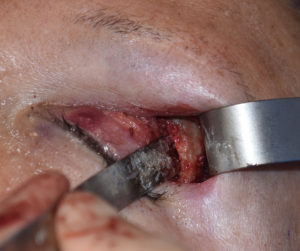Brow bone reduction surgery reduces the prominence of the lower forehead bone just above the eyes. It is most commonly done in men for large “Neanderthal’ like brow bone protrusions or in male to female transgender facial feminization surgery. Whether it is done using a bone burring method or a more complete osteoplastic bone flap setback technique depends on the thickness of the anterior wall of the frontal sinus and the amount of projection reduction needed.
One aspect of brow bone reduction surgery that can be overlooked is that of the tail of the brow bone. This is uniquely different from the inner half of the brow bone because it is solid bone with no underlying frontal sinus. Whether it needs to be reduced depends on what gender look one is trying to achieve. A more straight brow bone from one side to the other is more consistent with a male with an outward sweep or upwards arch to the tail of the brow bone is perceived as more feminine in appearance.

Elevating the lower border of the tail of the brow bone is done to help open up the eyes. By making the vertical distance between the superior and inferior orbital rims longer, the subsequent retraction of the soft tissue back down to the bone can potentially make the eyes look more open. If the forward projection of the elevated brow is also reduced an upward sweep to the tail of the brow can also be achieved.
Dr. Barry Eppley
Indianapolis, Indiana


